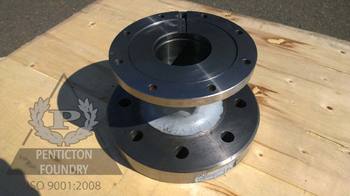Understanding Ductile Iron
on August 24, 2016Ductile iron is also called spherical graphite iron or nodular iron. It is known for its elongation, wear resistance, as well as its fatigue and impact resistance. Ductile iron was initially patented in 1948, but after a decade of intensive development, experienced a nine-fold increase in use as an engineering material.
Graphite occurs as spheroids in ductile iron and confers some unique properties as a result (graphite appears as individual flakes in gray iron). A small amount of Nodularizer is added to molten iron of a proper composition and certain minor elements are severely restricted in the base iron to ensure that the graphite spherical formation is not interfered with. The processing of ductile iron is made dependable by the use of several control procedures.
Ductile Iron Castings
Ductile iron castings are created when molten ductile iron is poured into a mold and allowed to cool, solidifying into a specific shape. Keep in mind that ductile iron is not a single material, but rather a group of materials. This means that different ductile irons will possess different properties, some of which may or may not work for a given application.
Read: In our blog post “Ductile Iron Versus Gray Iron Castings” we explore the differences between ductile iron and gray iron, including mechanical and physical properties, as well as typical applications.

Key Notes on Ductile Iron
- There are several advantages that ductile iron provides when it comes to casting due to the high carbon and silicon content.
- The graphite spheroids have minimal impact on the mechanical properties of ductile iron.
- Ductile iron demonstrates a stress/strain relation and a considerable range of yield strengths.
- Conversions to ductile iron from steel castings, forging and fabrications are often made due to the excellent castability and machinability of ductile iron. The ductile iron also has comparable (sometimes superior) properties and a lower density, which results in significant cost savings.
- Ductile iron provides a designer with an exceptional combination of toughness, low cost manufacturing, reliability and endurance.
Resource: Check out these data sheets, which focus on two different grades of ductile iron:
80 – 55 – 06 and 65 – 45 – 12.
To create different grades of ductile iron one must control the matrix structure around the graphite during the casting process, or through subsequent heat treatment. There are minor compositional differences that exist between the different grades of ductile iron. These differences exist in order to create the desired matrix microstructures. Special applications are feasible thanks to the unique properties of ductile irons, austempered ductile irons (ADI) and high alloy ductile irons.
Applications for Ductile Iron
Ductile iron has greater strength and ductility then gray iron and is subsequently used in the following applications:
- Cable drums
- Frames
- Gear boxes
- Pumps
- Pipe
- Hubs and machine frames for the wind power industry
- Agricultural tractors
The examples above are just a small fraction of the kinds of products that are made out of ductile iron. For more information on ductile iron, and to see links to our different ductile iron data sheets, check out our ductile iron webpage.

